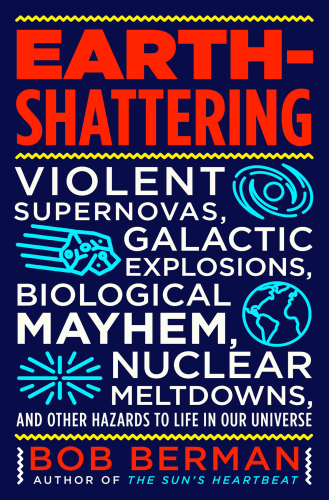
Earth-Shattering
Violent Supernovas, Galactic Explosions, Biological Mayhem, Nuclear Meltdowns, and Other Hazards to Life in Our Universe
کتاب های مرتبط
- اطلاعات
- نقد و بررسی
- دیدگاه کاربران
نقد و بررسی

December 15, 2018
The universe is a weird, warped, violent place. And that's the good news.Life is hard, and it'll be harder still when Andromeda goes sliding into the Milky Way in an inevitable collision of galaxies, even if "colliding galaxies are mostly smoke and mirrors." Fortunately, writes science writer and Astronomy columnist Berman (Zapped: From Infrared to X-rays, the Curious History of Invisible Light, 2017, etc.), this won't happen for "sometime sooner than four billion years from now." From the point of view of Earth, if there is an Earth, it'll just be a sort of weird warping of space and time. Cataclysm is the universe's constant; as the author writes, it's a "a bumper-car ride" out there, but more than that, it's a place where the collision of worlds produces startling effects. One example is our moon, which, by the increasingly regnant theory today, was born when a Mars-size planet with oxygen smacked into Earth, blowing a chunk out to become a satellite of our home. Against this backdrop, the current wave of mass extinctions of life on Earth has many precedents in our planet's history, which doesn't make it any more palatable. Berman writes with verve and vigor about such things as the Snowball/Slushball catastrophe, the Cambrian explosion, the meteor collision that produced the Chicxulub Crater ("giant tsunamis the height of sixty-story buildings spread across the Caribbean"), novas and supernovas and H-bomb tests, and all manner of suchlike terrors. Sometimes the prose can get cutesy, in the catchy way of pop-magazine writing: "And although the jury may be out on the success of the Big Bang...we members of Homo bewilderus can shrug it all off with a 'Don't blame me, I wasn't even there' innocence." But mostly, Berman's book is a pleasing excursion into the hows and whys of how the universe--our universe, anyway--took shape and how it works--except when it doesn't.Just the book for a bright teenager interested in astronomy and geosciences.
COPYRIGHT(2018) Kirkus Reviews, ALL RIGHTS RESERVED.

Astronomical disasters--whether past, present, or predicted--fascinate us, even if such events don't noticeably impact our individual lives. Astronomer Berman (Zapped: From Infrared to X-Rays, the Curious History of Invisible Light) flits through a sampling of cosmic cataclysms, ranging from the Big Bang to massive solar flares, examining the mechanisms of these destructive phenomena. Midbook, he meanders off track, dispatching the combined horrors of the Black Plague, the early 20th-century influenza pandemic, and World War II into shallow pages. Fortunately, he refocuses on the physical sciences, discussing infamous nuclear accidents, upcoming celestial incidents likely to inspire conspiracy and doomsday theories, and the predictable dismal fate awaiting all life forms on our home planet. VERDICT Beyond Berman's fan base, popular science readers who don't mind frequently interspersed unrelated commentary will appreciate the otherwise straightforward narrative of the physics underlying a variety of astronomical catastrophes. For more concentrated popular works on cosmology, see Brian Cox's Universal: A Guide to the Cosmos and Stuart Clark's The Unknown Universe: A New Exploration of Time, Space, and Cosmology.--Nancy R. Curtis, Univ. of Maine Lib., Orono
Copyright 1 Library Journal, LLC Used with permission.
January 1, 2019
It seems like ever since humans first appeared on this planet, we've obsessed over potential horrific cataclysms that could end us all. Prolific science-writer Berman (Zapped, 2017) here considers all sorts of literally earth-shattering events, from cosmic collisions and exploding black holes to earthquakes and tsunamis. In straightforward, accessible tech talk, he explains the science behind each phenomenon and muses about its actual potential to take us out, often incorporating a little pop culture (Scotty fretting over losing containment in the Enterprise's propulsion system) or macabre humor (trying to imagine citizens stampeding through streets, sf-movie style). Each brief chapter looks at another horror, such as pandemics (the bubonic plague, influenza) or man-made catastrophes (WWII, nuclear weapons). He addresses social implications, such as our eternal pessimism in consistently interpreting any new astronomical or geological event as a harbinger of doom, and our ongoing eagerness to embrace dire pseudo-science forecasts (remember the supposed 2012 Armageddon, as proposed by the Mayan calendar?). Whether ultimately alarmed or comforted, readers will come away enlightened and entertained.(Reprinted with permission of Booklist, copyright 2019, American Library Association.)

























دیدگاه کاربران